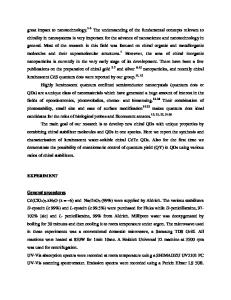Facile fabrication of fluorescent-superhydrophobic bifunctional ligand-free quantum dots
- PDF / 636,306 Bytes
- 7 Pages / 595.276 x 790.866 pts Page_size
- 68 Downloads / 311 Views
ORIGINAL CONTRIBUTION
Facile fabrication of fluorescent-superhydrophobic bifunctional ligand-free quantum dots Qiang Zhang & Jian Yang & Cai-Feng Wang & Qiao-Ling Chen & Su Chen
Received: 29 March 2012 / Revised: 19 June 2012 / Accepted: 18 August 2012 / Published online: 19 September 2012 # Springer-Verlag 2012
Abstract We present herein a facile strategy for fabrication of fluorescent-ultrahydrophobic bifunctional ligand-free CdS quantum dots (QDs) using cadmium acetate, sodium sulfide as starting materials, and ethanol as the solvent. The as-prepared CdS QDs without ligands exhibit good photochemical stability and photoluminescence (PL) in comparison with the previously reported aqueous CdS QDs. The effects of various experimental variables, including Cd/S molar ratio, reaction time, and reaction temperature on the optical properties of the obtained CdS QDs have been systematically investigated. Subsquently, dodecanethiol was introduced to modify these CdS QDs, further conferring them with superhydrophobic property, along with good compatibility with polymers. The features and structures of the as-prepared QDs and their hybrids on UV–Vis, PL spectroscopy, Fourier transform infrared, transmission electron microscope, X-ray diffraction, and contact angle have been disscussed. Keywords Ligand-free synthesis . CdS quantum dots . Poly (methyl methacrylate) . Luminescence . Superhydrophobicity
Introduction Semiconductor quantum dots (QDs) have attracted great attention because of their extensive scientific and industrial interest in areas such as light-emitting devices [1, 2], Q. Zhang : J. Yang : C.-F. Wang : Q.-L. Chen : S. Chen (*) State Key Laboratory of Materials-Oriented Chemical Engineering, College of Chemistry and Chemical Engineering, Nanjing University of Technology, Nanjing 210009, People’s Republic of China e-mail: [email protected]
nonlinear optical devices [3, 4], and biological labels [5, 6]. Until now, a large number of techniques, such as hightemperature trioctylphosphine oxide-trioctylphosphine approach [7], hydrothermal method [8], microwave-assisted chemical bath deposition [9], and chemical aerosol flow synthesis [10], have been rapidly proposed for QDs. However, the synthesis of QDs with the ligands in many cases is still not satisfactory mainly due to the easy detachment of the ligand from the QDs existing in the polymer matrices, thereby causing luminescence diminishing or quenching of QDs and limiting their applications. Therefore, it is still a great challenge to develop new strategies for preparation of QDs without ligands. In this aspect, Li and co-workers reported the direct assembly of highly uniform ZnO mesoporous ellipsoids from ligand-free ZnO QDs of ∼5 nm at room temperature [11]. Janiak's group developed a step-bystep, “ligand-free” nucleation and nanocrystal growth of gold nanoparticles by the reduction of KAuCl4 with SnCl2 in ionic liquids [12]. Mertens et al. demonstrated the synthesis of ligand-free Au clusters which display quantized charging [13]. These motivated us to exp
Data Loading...








